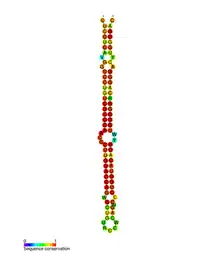miR-150
miR-150 is a family of microRNA precursors found in mammals, including humans. The ~22 nucleotide mature miRNA sequence is excised from the precursor hairpin by the enzyme Dicer.[1] This sequence then associates with RISC which effects RNA interference.[2]
| miR-150 | |
|---|---|
 Conserved secondary structure of miR-150 microRNA precursor | |
| Identifiers | |
| Symbol | miR-150 |
| Alt. Symbols | MIR150 |
| Rfam | RF00767 |
| miRBase | MI0000479 |
| miRBase family | MIPF0000197 |
| NCBI Gene | 406942 |
| HGNC | 31537 |
| OMIM | 610566 |
| RefSeq | NR_029703 |
| Other data | |
| RNA type | miRNA |
| Domain(s) | Mammalia |
| GO | 0035195 |
| SO | 0001244 |
| Locus | Chr. 19 q13.33 |
| PDB structures | PDBe |
miR-150 functions in hematopoiesis; it regulates genes whose downstream products encourage differentiating stem cells towards becoming megakaryocytes rather than erythrocytes.[3][4] It is also thought to control B and T cell differentiation, alongside mir-155.[5][6]
Role in cancer
miR-150 has been linked with a number of cancers. It is thought to promote cancer cell proliferation in gastric cancer and has also been found to be more than 50x overexpressed in osteosarcoma.[7]
Applications
miR-150 levels in blood plasma can be indicative of early sepsis; it could have a future use therapeutically in treating the condition.[8] In addition, miR-150 is one of a number of microRNAs whose expression profile could be used as a biomarker of hepatocellular carcinoma.[9]
References
- Ambros V (Dec 2001). "microRNAs: tiny regulators with great potential". Cell. 107 (7): 823–6. doi:10.1016/S0092-8674(01)00616-X. PMID 11779458. S2CID 14574186.
- Gregory RI, Chendrimada TP, Cooch N, Shiekhattar R (Nov 2005). "Human RISC couples microRNA biogenesis and posttranscriptional gene silencing". Cell. 123 (4): 631–40. doi:10.1016/j.cell.2005.10.022. PMID 16271387. S2CID 16973870.
- Lu J, Guo S, Ebert BL, Zhang H, Peng X, Bosco J, Pretz J, Schlanger R, Wang JY, Mak RH, Dombkowski DM, Preffer FI, Scadden DT, Golub TR (Jun 2008). "MicroRNA-mediated control of cell fate in megakaryocyte-erythrocyte progenitors". Developmental Cell. 14 (6): 843–53. doi:10.1016/j.devcel.2008.03.012. PMC 2688789. PMID 18539114.
- Edelstein LC, Bray PF (May 2011). "MicroRNAs in platelet production and activation". Blood. 117 (20): 5289–96. doi:10.1182/blood-2011-01-292011. PMC 3109704. PMID 21364189.
- Vasilatou D, Papageorgiou S, Pappa V, Papageorgiou E, Dervenoulas J (Jan 2010). "The role of microRNAs in normal and malignant hematopoiesis". European Journal of Haematology. 84 (1): 1–16. doi:10.1111/j.1600-0609.2009.01348.x. PMID 19744129. S2CID 46395419.
- Garzon R, Croce CM (Jul 2008). "MicroRNAs in normal and malignant hematopoiesis". Current Opinion in Hematology. 15 (4): 352–8. doi:10.1097/MOH.0b013e328303e15d. PMID 18536574. S2CID 12931709.
- Lulla RR, Costa FF, Bischof JM, Chou PM, Bonaldo MF, Vanin EF, Soares MB (2011). "Identification of Differentially Expressed MicroRNAs in Osteosarcoma". Sarcoma. 2011: 732690. doi:10.1155/2011/732690. PMC 3140035. PMID 21789031.
- Vasilescu C, Rossi S, Shimizu M, Tudor S, Veronese A, Ferracin M, Nicoloso MS, Barbarotto E, Popa M, Stanciulea O, Fernandez MH, Tulbure D, Bueso-Ramos CE, Negrini M, Calin GA (2009-10-12). Gold JA (ed.). "MicroRNA fingerprints identify miR-150 as a plasma prognostic marker in patients with sepsis". PLOS ONE. 4 (10): e7405. doi:10.1371/journal.pone.0007405. PMC 2756627. PMID 19823581.
- Magrelli A, Azzalin G, Salvatore M, Viganotti M, Tosto F, Colombo T, Devito R, Di Masi A, Antoccia A, Lorenzetti S, Maranghi F, Mantovani A, Tanzarella C, Macino G, Taruscio D (Aug 2009). "Altered microRNA Expression Patterns in Hepatoblastoma Patients". Translational Oncology. 2 (3): 157–63. doi:10.1593/tlo.09124. PMC 2730135. PMID 19701500.
Further reading
- Tsitsiou E, Lindsay MA (Aug 2009). "microRNAs and the immune response". Current Opinion in Pharmacology. 9 (4): 514–20. doi:10.1016/j.coph.2009.05.003. PMC 2742742. PMID 19525145.
- Jiang X, Huang H, Li Z, Li Y, Wang X, Gurbuxani S, Chen P, He C, You D, Zhang S, Wang J, Arnovitz S, Elkahloun A, Price C, Hong GM, Ren H, Kunjamma RB, Neilly MB, Matthews JM, Xu M, Larson RA, Le Beau MM, Slany RK, Liu PP, Lu J, Zhang J, He C, Chen J (Oct 2012). "Blockade of miR-150 maturation by MLL-fusion/MYC/LIN-28 is required for MLL-associated leukemia". Cancer Cell. 22 (4): 524–35. doi:10.1016/j.ccr.2012.08.028. PMC 3480215. PMID 23079661.